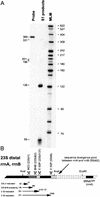Transcription analysis of two disparate rRNA operons in the halophilic archaeon Haloarcula marismortui
- PMID: 9733681
- PMCID: PMC107503
- DOI: 10.1128/JB.180.18.4804-4813.1998
Transcription analysis of two disparate rRNA operons in the halophilic archaeon Haloarcula marismortui
Abstract
The genome of the halophilic archaeon Haloarcula marismortui contains two rRNA operons designated rrnA and rrnB. Genomic clones of the two operons and their flanking regions have been sequenced, and primary transcripts and processing intermediates derived from each operon have been characterized. The 16S, 23S, and 5S genes from the two operons were found to differ at 74 of 1,472 positions, 39 of 2,922 positions, and 2 of 122 positions, respectively. This degree of sequence divergence for multicopy (paralogous) rRNA genes was 10- to 50-fold or more higher than anticipated. The two operons exhibit other profound differences that include (i) the presence in rrnA and the absence in rrnB of tRNAAla and tRNACys genes in the intergenic and distal regions, respectively, (ii) divergent 5' flanking sequences, and (iii) distinct pathways for processing and maturation of 16S rRNA. Processing and maturation of 16S and 23S rRNA from rrnA operon transcripts and of 23S rRNA from rrnB operon transcripts follow the canonical halophilic pathway, whereas maturation of 16S rRNA from rrnB operon transcripts follows an unusual and different pathway that is apparently devoid of any 5' processing intermediate.
Figures






Similar articles
-
Intragenomic 16S rDNA divergence in Haloarcula marismortui is an adaptation to different temperatures.J Mol Evol. 2007 Dec;65(6):687-96. doi: 10.1007/s00239-007-9047-3. Epub 2007 Nov 17. J Mol Evol. 2007. PMID: 18026684
-
Sequence heterogeneity between the two genes encoding 16S rRNA from the halophilic archaebacterium Haloarcula marismortui.Genetics. 1992 Mar;130(3):399-410. doi: 10.1093/genetics/130.3.399. Genetics. 1992. PMID: 1372578 Free PMC article.
-
First complete nucleotide sequence and heterologous gene organization of the two rRNA operons in the phytoplasma genome.DNA Cell Biol. 2003 Mar;22(3):209-15. doi: 10.1089/104454903321655837. DNA Cell Biol. 2003. PMID: 12804119
-
Molecular cloning and comparative sequence analyses of rRNA operons in Streptomyces nodosus ATCC 14899.Gene. 1999 May 17;232(1):77-85. doi: 10.1016/s0378-1119(99)00112-2. Gene. 1999. PMID: 10333524
-
Reprint of New opportunities for improved ribotyping of C. difficile clinical isolates by exploring their genomes.J Microbiol Methods. 2013 Dec;95(3):425-40. doi: 10.1016/j.mimet.2013.09.009. Epub 2013 Sep 16. J Microbiol Methods. 2013. PMID: 24050948 Review.
Cited by
-
Temperature-dependent expression of different guanine-plus-cytosine content 16S rRNA genes in Haloarcula strains of the class Halobacteria.Antonie Van Leeuwenhoek. 2019 Feb;112(2):187-201. doi: 10.1007/s10482-018-1144-3. Epub 2018 Aug 20. Antonie Van Leeuwenhoek. 2019. PMID: 30128892 Free PMC article.
-
Analysis of intergenic spacer region length polymorphisms to investigate the halophilic archaeal diversity of stromatolites and microbial mats.Extremophiles. 2007 Jan;11(1):203-10. doi: 10.1007/s00792-006-0028-z. Epub 2006 Nov 3. Extremophiles. 2007. PMID: 17082971
-
Mapping posttranscriptional modifications in 5S ribosomal RNA by MALDI mass spectrometry.RNA. 2000 Feb;6(2):296-306. doi: 10.1017/s1355838200992148. RNA. 2000. PMID: 10688367 Free PMC article.
-
Comprehensive analysis of the pre-ribosomal RNA maturation pathway in a methanoarchaeon exposes the conserved circularization and linearization mode in archaea.RNA Biol. 2020 Oct;17(10):1427-1441. doi: 10.1080/15476286.2020.1771946. Epub 2020 Jun 19. RNA Biol. 2020. PMID: 32449429 Free PMC article.
-
An archaeal RNA binding protein, FAU-1, is a novel ribonuclease related to rRNA stability in Pyrococcus and Thermococcus.Sci Rep. 2017 Oct 4;7(1):12674. doi: 10.1038/s41598-017-13062-3. Sci Rep. 2017. PMID: 28978920 Free PMC article.
References
-
- Dennis, P. P. Expression of ribosomal RNA operons in halophilic archaea, In A. Oren (ed.), Microbiology and biogeochemistry of hypersaline environments, in press. CRC Press, Inc., Boca Raton, Fla.
-
- Dennis P P. Multiple promoters for the transcription of the ribosomal RNA gene cluster in Halobacterium cutirubrum. J Mol Biol. 1985;186:456–461. - PubMed
Publication types
MeSH terms
Substances
LinkOut - more resources
Full Text Sources

